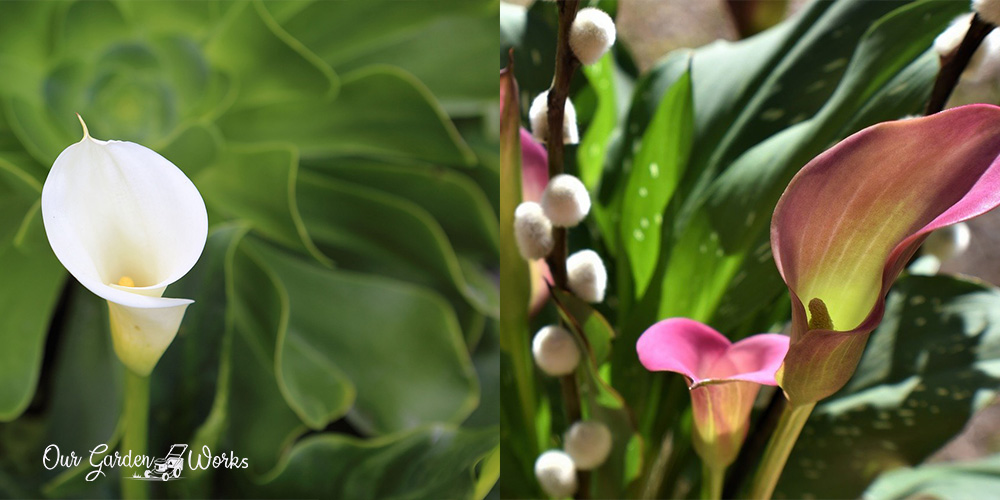Leaf curling is a common sign of stress in plants. It can indicate environmental stress, overwatering, or pest damage which all weaken the plant.
As one of the most favored houseplants, calla lily leaf curling can cause major concern to gardeners since it can also affect the overall aesthetic of the plant.
If you’ve been checking online, you may notice that there are only a few that share different indications of leaf curling patterns in plants. Another unpopular piece of information is that calla lily comes in two varieties that determine their climate and soil preferences.
These details are often overlooked by homeowners that hold a big impact in keeping calla lilies happy and healthy.
In this post, we will share the two groups of calla lilies and the different curling patterns that can help you easily identify the cause of stress in your plant.
Getting To Know Calla Lilies
Popular as flowers for weddings, the calla lily is a tropical plant that produces long-lasting blooms that last for several weeks. It may have the term lily in its name but it’s not a true lily.
It is a member of the plant family Araceae. True lilies grow from bulbs but calla lilies grow from rhizomes which is a clear indication of their difference from the true lilies.
Calla lilies are loved for their versatility. They can be treated as outdoor plants or houseplants in pots.
Since they are from a tropical habitat, they prefer a humid and moist environment. They also thrive in full sun depending on the local climate.
Generally, calla lilies in cool climates enjoy full sun but in warm climates, they enjoy the morning sun and afternoon partial shade.
Some distinct preferences may occur if you have a specific calla lily variety since two of its distinct groups have their own growing requirements.
Two types of calla lilies
Most people receive calla lilies as gifts or found them in a nursery thinking all calla lilies are the same.
There’s a common misconception that both white and colored calla lilies can thrive in the same environment. So, placing the wrong kind in full sun can cause stress like leaf curling.
Learn more about these types below:
White calla lily (Zantedeschia Aethiopica)
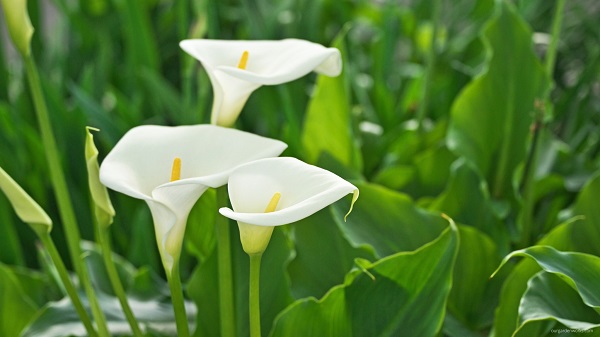
The white calla lilies (Zantedeschia Aethiopica) or arum lilies originated from the west coast of South Africa wherein they thrive in wet conditions.
Their natural habitat is directly influenced by the cool breeze from the Atlantic Ocean that’s why they thrive in cool and moist or even wet soil. They also prefer a mix of sun and shade to grow well.
According to the University of Illinois Chicago (UIC) Garden, arum lilies are considered marginal aquatic plants which means they can thrive around bodies of water like banks, streams, and koi ponds.
If you have a water garden, adding white calla lilies on the edges can add up to the overall ambiance of the landscape.
White calla lilies are tough and once a gardener grows them, they’ll be hard to get rid of. That is also the reason why some countries like Australia consider calla lily as an invasive and problem plant.
Colored calla lilies
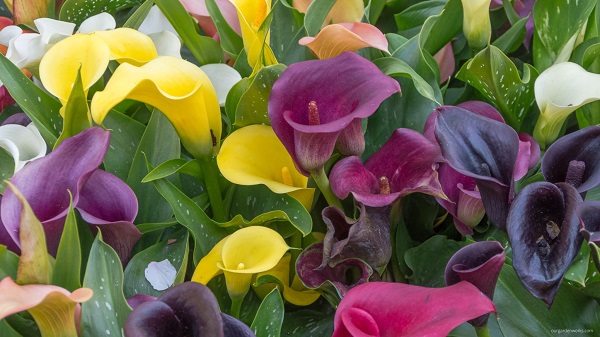
According to the University of Florida, colored calla lilies or Zantedeschia hybrids thrive in a dry and warm climate and cannot tolerate wet conditions, which makes them more prone to rotting.
The colored calla lily varieties originated from the east coast of South Africa facing the Indian Ocean where its climate is warm to hot. So their habitat is quite different and they’re not considered as marginal aquatic plants.
Colored calla lilies like Zantedeschia rehmannii, prefer a sunny location and cool night temperatures to produce the best flower quality.
However, in hot regions like southern California, they’ll do better in partial shade. If you’re in the northwestern part of the US, they can thrive in full sun.
White calla lilies grow flowers as long they have optimal growing conditions. However, calla lily hybrids need to be dormant between flowerings to produce good-quality flowers.
The bulbs of colored calla lilies are also different from the white ones. They have a tuber that looks like a sun shape. Whereas, the rhizome of a white calla lily is longer and thicker.
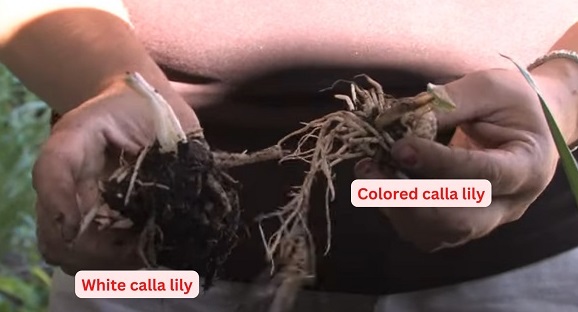
Since calla lilies are prone to rotting, they can show early problem signs like calla lily leaf curling. They need extra attention when it comes to moisture.
During their dormancy period in winter, the soil must be left to dry. Otherwise, the roots will rot easily.
5 Kinds of Calla Lily Leaf Curling and What It Means
Stressed calla lilies usually give off some signs of what could possibly be causing the leaf to curl. Check the pattern of the curling below and the solution to each condition:
Down curl: Drought or heat stress
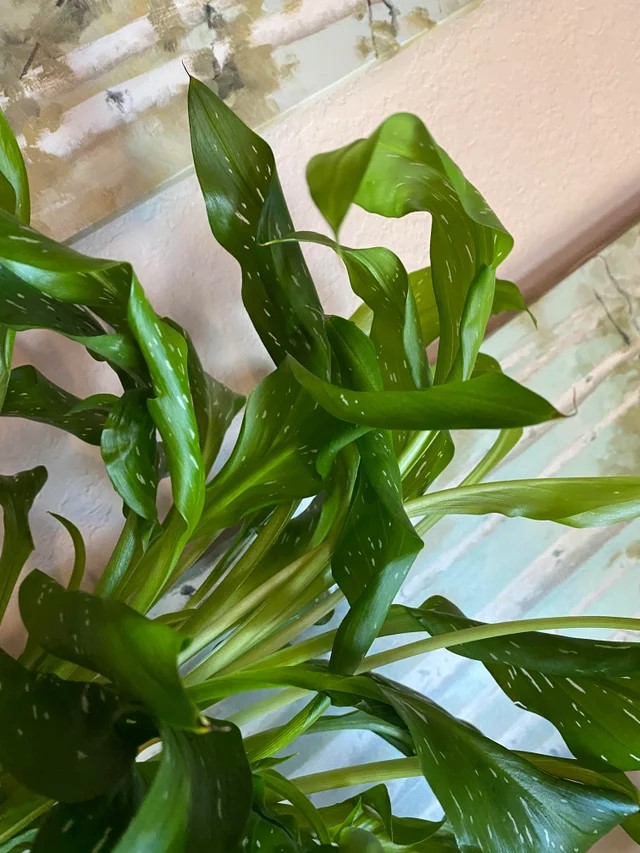
The down curl of calla lily leaves is the attempt of the plant to avoid further water loss.
Though calla lilies are tropical plants, they can also experience drought or heat stress when the climate exceeds 60℉ to 80℉.
White calla lilies, in particular, love wet conditions and may suffer periodic drought when the weather is too hot or it is placed in the scorching afternoon sun.
When plants experience heat stress, they activate their self-preservation system and close some leaf pores on the underside of the leaves, resulting in a downward curl. It usually happens when the plant no longer gets enough moisture from the roots.
How to treat dehydrated and heat-stressed calla lilies
The good thing about dehydrated calla lilies is they can still recover within minutes and the leaves will still uncurl.
Water the calla lily and move it to a location with partial shade to protect it from the scorching sun. Increase the watering routine if the weather is particularly hotter than usual.
Potted calla lilies are more prone to drought stress, especially white calla lilies. So, you might need to water them frequently to maintain the vigor of their leaves.
If you have colored calla lilies, refrain from watering them too much during fall since they’re very prone to root rot.
Up curl: Environmental stress due to too much sun and the start of dormancy preparation
If the leaves are curling upwards, it indicates the attempt of the plant to protect itself from environmental stress like too much direct sun and strong winds.
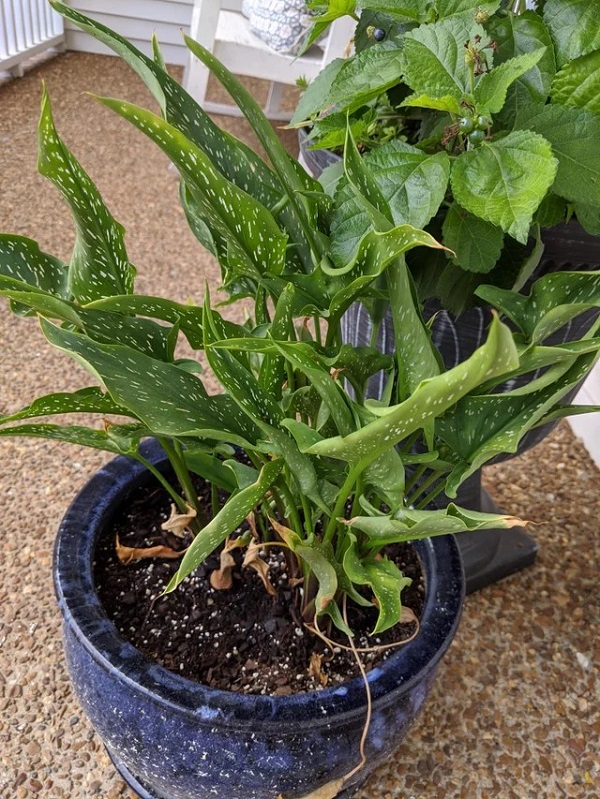
Sadly, this type of calla lily leaf curl will not recover its former form. If all of the leaves of the calla lily are curling, it is an indication that it is in deep stress.
Calla lilies enjoy full 6 hours of sun in cool and temperate climates. In warm climates, both white and colored calla lilies will need extra protection from afternoon sun to avoid sun damage.
Otherwise, the plant will activate its self-preservation system and attempt to lessen the leaf surface and mitigate the sun damage on the leaf tissues by curling upwards.
If the colored calla lily is starting to curl upwards and starts to droop in fall, it is starting to enter its dormancy period. Stop the fertilization and watering, and let it dry out throughout the winter to prevent root rot.
White calla lilies don’t have any problem with excess water in the pot since they can tolerate wet conditions.
How to treat calla lilies exposed to too much sun
Allow the stressed calla lily to stay in the shade until it recuperates. Try not to stress it even further by using fertilizers.
You should also water it well to help the plant regenerate new plant tissues and recover properly.
Down curl with droopy leaves: overwatering and root rot

The down curl accompanied with droopy behavior of calla lily leaves may indicate over-watering issues, especially on colored calla lilies. Since white calla lilies thrive in wet conditions, it is unlikely to overwater them.
Aside from calla lily leaf curling, other telltale signs of overwatering include:
- Yellowing leaves.
- Root rot spreading to the stem.
- Mold and mildew developing on the leaves.
If the colored calla lily has few green leaves but rotten roots, it still has a slim chance to live. Re-pot the calla lily and try to trim the rotten parts before placing it in the new pot. Avoid watering for two or more days.
Sideward curling with wrinkling and yellowing: pest damage
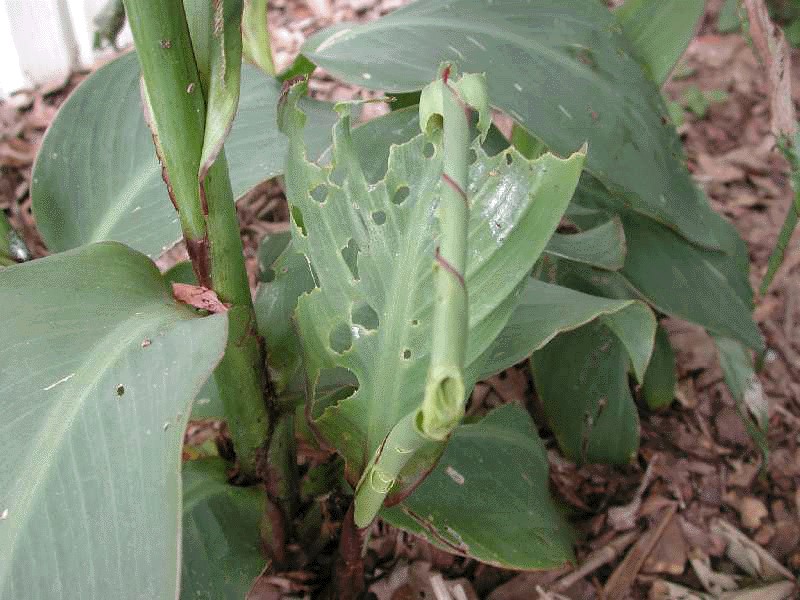
When the leaves of calla lilies start to curl sidewards, have yellow patches and visible leaf injuries, it can be caused by some pests.
If you look closely or at the underside of the leaves, you might notice the pests. When pests are feeding on the leaves, the leaf tissues will dry out. They will also start to curl and have brown and yellow patches.
To deal with pests, you can wipe the leaves with soapy water. For heavy Infestation, spray the calla lily with neem oil or synthetic pesticide.
If you will use neem oil, make sure to apply it early in the morning or late in the afternoon to avoid burning the leaves.
Upward curling with yellow patches: Manganese or magnesium deficiency
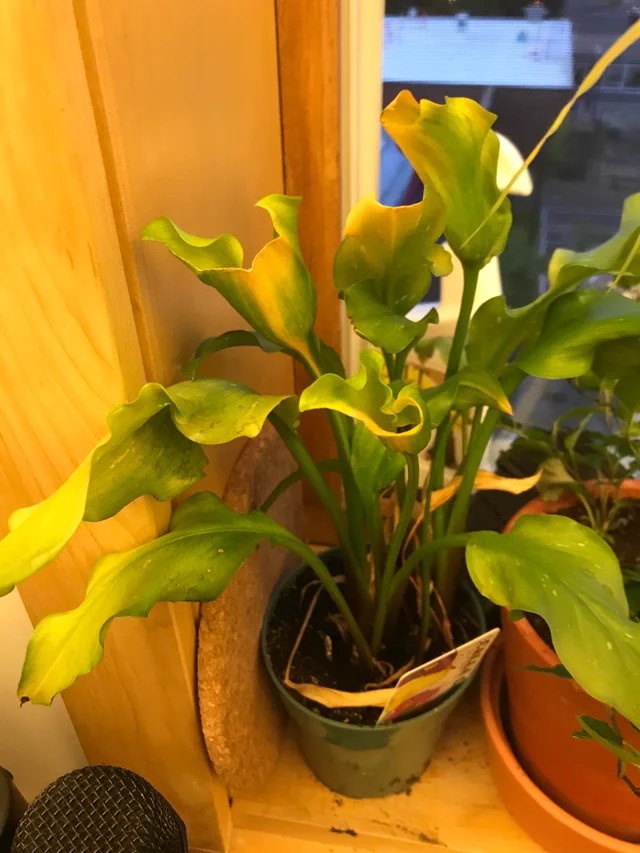
When your calla lily develops yellowing and curling leaves with veins that remain green, it is most likely dealing with magnesium deficiency.
The signs often manifest in older leaves of calla lilies and not in the new growth. You must treat this nutrient deficiency using diluted Epsom salt.
On the other hand, if the calla lily is suffering from manganese deficiency, the curling and yellow patches will affect the new leaves.
Manganese is important in helping calla lilies process sunlight and contributes to photosynthesis. So, without it, your calla lilies will have a weak defense against the sun.
Treat manganese deficiency by using a fertilizer enriched with extra nutrients that include manganese and magnesium.
Before fertilizing your calla lilies, make sure that the soil pH level is on the right track. Otherwise, the nutrients will just leach into the soil and not be absorbed by the roots.
The ideal soil pH level of calla lily is slightly acidic which falls from 5.0 to 6.5. Use a soil pH meter to identify the soil acidity and apply sulfur if it’s too alkaline and lime if it’s too acidic.
For maintenance feeding, you can apply balanced liquid fertilizer or fish emulsion twice a month. Try to avoid applying too much nitrogen on calla lilies to reduce their vegetative growth and encourage them to develop more long-lasting blooms.
Pro Tip: If your calla lily leaf curling also comes with brown tips, the water quality might be the culprit. Fluoride that is usually mixed in the city water supply can cause salt accumulation in the soil and burn the leaves. If you experience this, leach the salts in the soil by placing the pot in running water for a few minutes to dissolve the salts.
Final Thoughts
There is a multitude of sources that talk about calla lily and its growing requirements.
However, only a few will discuss the difference between white and colored calla lilies in terms of their environment and soil preferences. So, we hope this post will debunk the misconceptions and save a lot of dying calla lilies due to improper care.
We hope that this post also helped you understand your plants better based on their leaf curling patterns.
Let us know in the comments about your experience in dealing with calla lily leaf problems and how you dealt with them.
Also, please spread the word and share this essential calla lily information and save more calla lilies from the brink of death.
